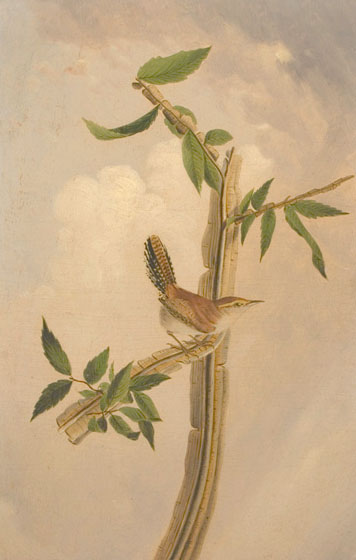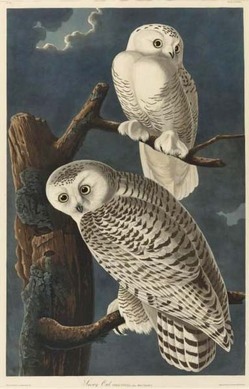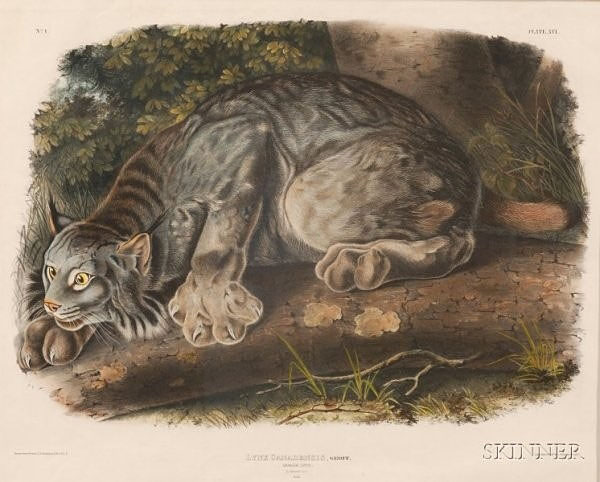John James Audubon (1785 to 1851)
John James Audubon was born in Haiti on April 26, 1785 on a sugar plantation, the son of Lt. Jean Audubon, a French naval officer, and Audubon’s mistress, Jeanne Rabin, a Louisiana chambermaid. After the death of Jeanne Rabin and a slave uprising that convinced Audubon’s father to give up his holdings in the colony, John James Audubon, still a toddler, and his younger sister returned to France where they were raised by their father and stepmother. In 1789, Lt. Audubon formally adopted the children, listing John James’s name as Jean-Jacques Fougere Audubon, a name that Audubon would anglicized in 1803 when he immigrated to America.
The young Audubon always loved birds, and his father encouraged his awareness of nature. Despite coming of age during some very turbulent times in France, Audubon’s childhood seems peaceful, and he was skilled in all the arts of the day – music, riding, fencing, etc. At twelve, his father put into motion plans to make his son a sailor, but with an aptitude for seasickness and not for math, these efforts failed.
In 1803, facing the fear of conscription into the Napoleonic Wars, Audubon set sail for the United States with a forged passport, bound for the family farm, Mill Grove, near Valley Forge, where it was hoped that he could develop the mining potential of the property and earn an adequate living. After a bout of yellow fever during the crossing, the ship’s captain left him in a Quaker-run boarding house, where he learned English during his recuperation before traveling to Mill Grove.
At Mill Grove, Audubon soon made the acquaintance of his neighbor, William Bakewell, as well as Bakewell’s daughter, Lucy. Audubon and Lucy quickly discovered that they had a great deal in common, spending time exploring the natural world together and Audubon began studying American birds in earnest. After contracting a fever and being nursed back to health by Lucy, Audubon decided he needed to return to France to seek his father’s blessing to marry and to make some plans for the family business ventures.
While in France in 1805, he met Charles-Marie D’Orbigny, a physician by trade and naturalist by hobby, who helped Audubon with his taxidermy efforts. He also encouraged Audubon to take a more scientific and orderly approach to his research, and Audubon returned to Mill Grove inspired. His renewed energy led to the creation of a nature museum, a space he quickly filled with products of his taxidermy, which improved as he labored to complete examples.
After abandoning the mining development, Audubon sold a portion of Mill Grove and traveled to New York, where he hoped to develop a business that would allow him to marry Lucy, as William Bakewell was reluctant to give his blessing to the young couple until Audubon demonstrated that he was able to support a family. Audubon opted to travel to Louisville, Kentucky, the booming Ohio River city, where he set himself up as a general store manager. Lucy followed in 1808 and the couple married. Children soon followed with sons Victor (1809) and John (1812), along with two daughters who died in infancy.
Unfortunately, like many storekeepers of the era, Audubon’s business struggled in the wake of Jefferson’s embargo act, and the Audubons moved to Henderson, Kentucky, where they quickly adapted to the frontier lifestyle. As business failed to pick up, Audubon found himself outdoors more and more often, hunting and fishing to feed the family.
Audubon was dealt another setback in 1812, when, after a visit back to Philadelphia, he returned home to find his entire collection of drawings devoured by rats, and yet again when the War of 1812 prevented him from relocating the family and the business to New Orleans. After partnering with his brother-in-law, things for the Audubons seemed to improve for several years. (At least financially, daughters Lucy and Rose died in 1817 and 1820, respectively.) However, hard times came again as the result of the Panic of 1819, and Audubon quickly found himself bankrupt and in jail as a debtor. Still, he continued to practice his skills as an artist, claiming small fees for portrait sketches.
Around this time, Audubon made set a lofty goal for himself, hoping to paint all the birds of North America. In the fall of 1820, the family headed south to document the birds of another region, with Audubon finding work for a time as a drawing tutor in Louisiana. Audubon continued to exchange his talents for goods or cash, drawing and painting portraits and offering lessons. (A good bit of the cash likely went back into lessons as Audubon studied with Thomas Cole, Thomas Sully, and other noted artists of the period whenever the opportunity present itself.) Meanwhile, most of the family’s support came from Lucy who taught school and tutored the children of wealthy Louisiana landowners.

An early oil-on-board painting by John James Audubon, done while the family was living near Oakley Plantation in Louisiana. (p4A item # D9791773)
Still, Lucy never lost faith in her husband, and in 1824, he returned to Philadelphia in the hopes of finding someone to publish his drawings. Despite a great deal of encouragement from the city’s artists, he had no luck, perhaps because of ill will on the part of some members of the Academy of Natural Sciences. After returning home, however, Lucy encouraged him to follow the advice he’d received in Philadelphia to travel to England, and in 1826, Audubon sailed from New Orleans with more than 300 of his drawings.
The British were fascinated with these first-hand images of the American frontier, and Audubon achieved celebrity status, touring the British Isles and raising funds for publication. Despite the huge printing costs (in excess of $115,000), Birds of America, complete with 435 hand-colored prints and the culmination of fourteen years of drawing, entered the publication process. Engraved copper plates, approximately 39 by 26 inches, produced prints that were then colored assembly line-style by dozens of colorists.

Audubon’s snowy owls, one of his few night scenes and one of the most highly valued of his prints. (p4A item # D9776242)
Audubon’s success was largely due to innovation. He worked with and portrayed birds and animals in different ways, shooting them with small shot and then using taxidermy methods to prepare them and position them from wire. His keen observation allowed him to pose them in motion, making them seem far more lifelike and interesting than they did in the work of his contemporaries. By using multiple birds in a single illustration, he could depict the male and female of the species and use a variety of postures to show the variety of markings.
Audubon headed home again in 1829, having conquered Britain and Europe and able to count kings and noblemen among his subscribers. Despite struggles with quality and debt, Birds of America went on to success, as did Audubon’s followup, Ornithological Biographies, and Audubon returned to the field, making numerous expeditions and working tirelessly, making time during the 1830s for another trip to England, accompanied by Lucy this time. His health began to worry him, and he was driven to travel and work to drum up subscriptions and interest, hoping to leave a comfortable income for his family. After relocating them to an estate on the Hudson River, he published another edition of Birds of America, this one in octavo size and with additional plates.

The first octavo American edition of Birds of America. (p4A item # D9978800)
Despite his best efforts, by 1848, Audubon began to slide into senility and dementia, and he died at home on January 27, 1851. His final project, Viviparious Quadrupeds of North America, done in connection with Rev. John Bachman and published in 1852, was completed by his sons and son-in-law, with his son John finishing most of the drawings.

A Canada lynx folio from the Audubon and Bachman Viviparious Quadrupeds of North America. (p4A item # D9846219)
Hollie Davis, p4A Senior Editor, August 11, 2009
